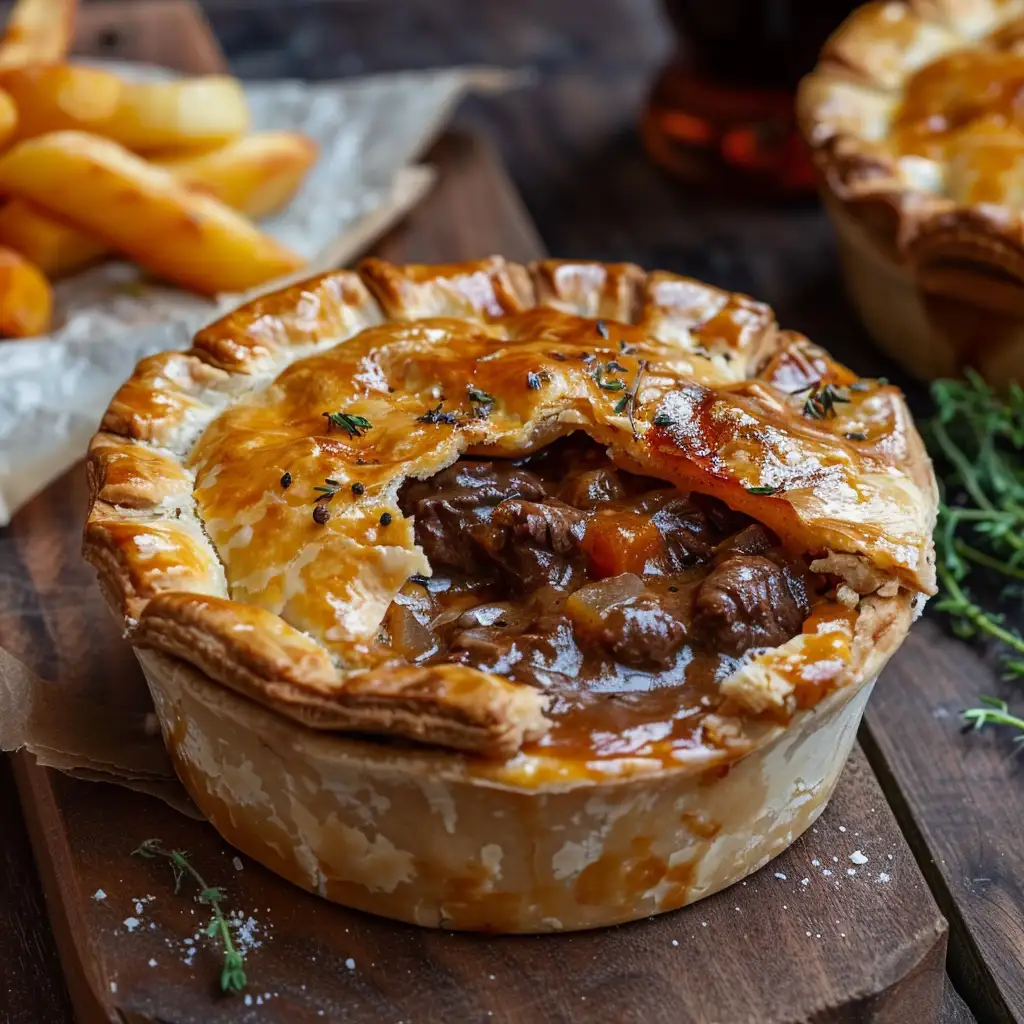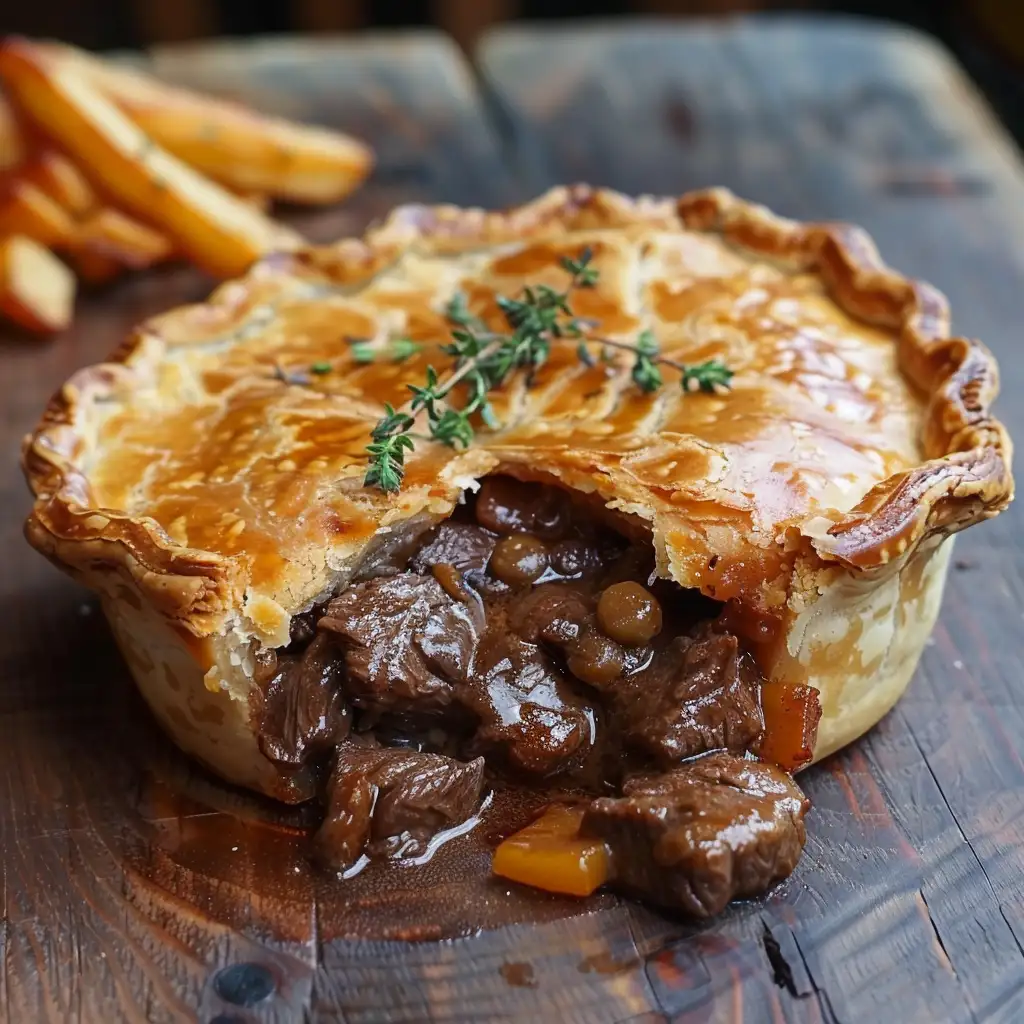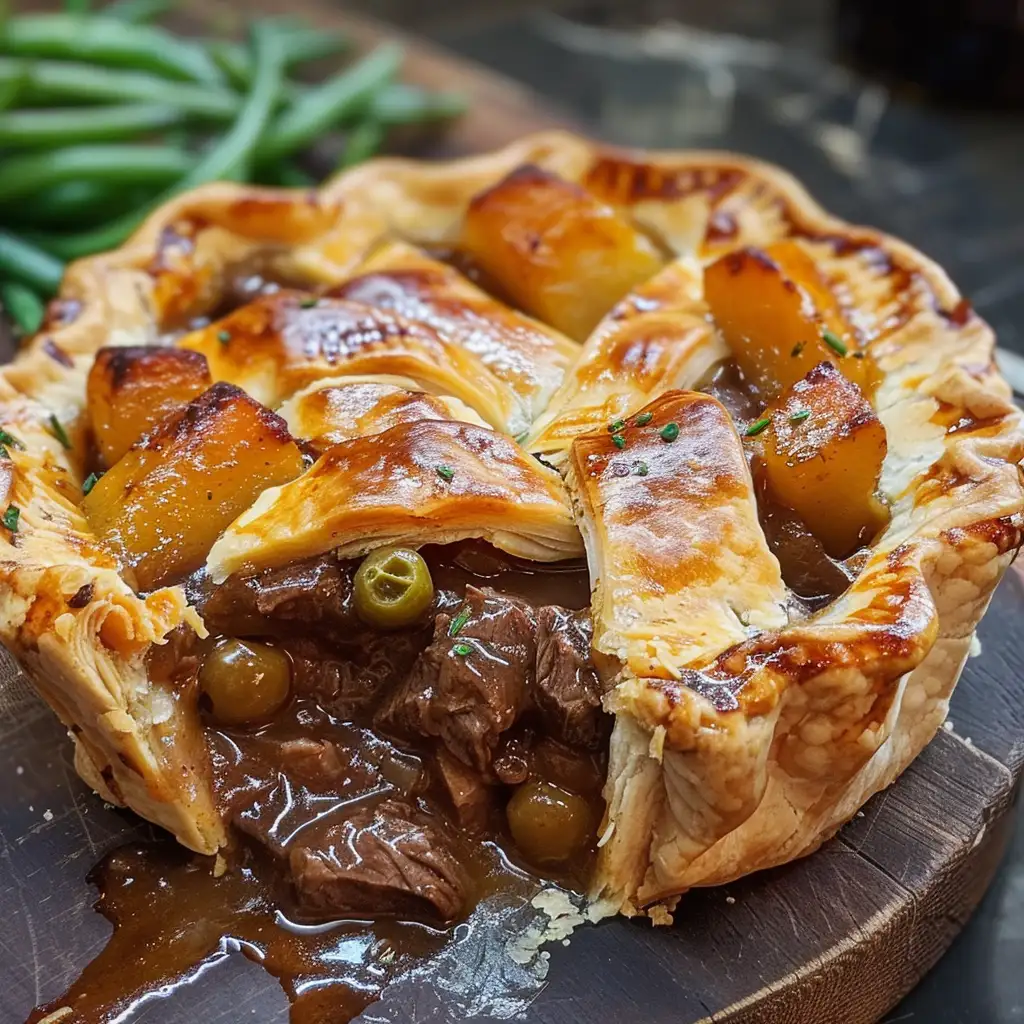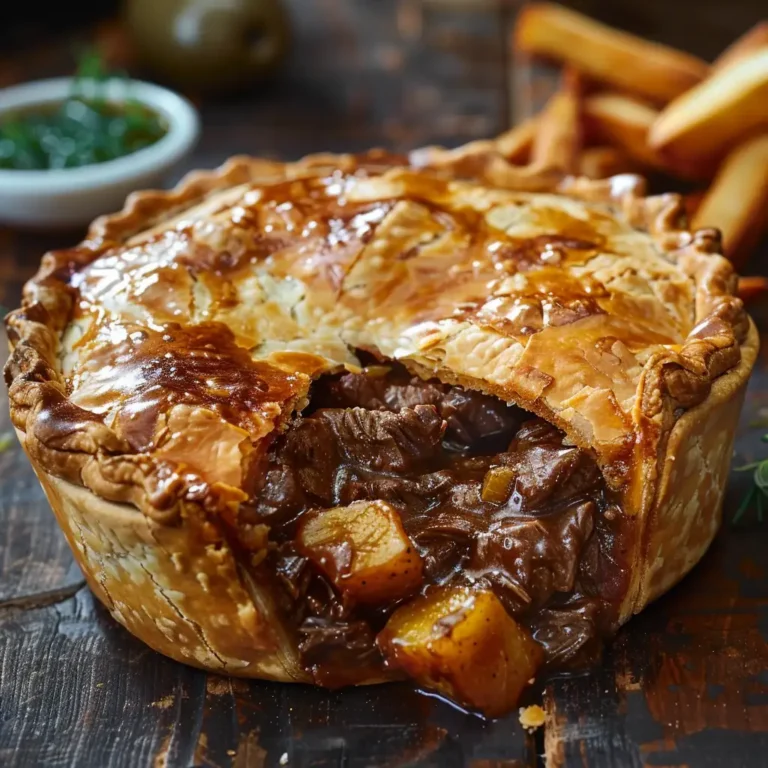Introduction to Steak and Kidney Pie
Steak and Kidney Pie, a staple in British cuisine, embodies a rich culinary tradition. This dish’s roots extend deeply into the UK’s food history, illustrating the evolution of British gastronomy from simple meat pies to the more complex and flavor-rich recipes we enjoy today.
History and Origin
- Early Versions: Initially, meat pies were basic, consisting of coarse pastry shells filled with meat, fat, and little seasoning. Over time, as spices became more accessible in Britain, these pies evolved in flavor and complexity.
- 19th Century Developments: The addition of kidneys—especially from lamb and pork—introduced a new depth of flavor to the pies, distinguishing them from other meat pies and paving the way for the steak and kidney pie we know today.
Cultural Significance
Steak and kidney pie is not just food; it’s a part of British heritage. Featured in countless novels and poems, the pie symbolizes comfort and home cooking. It is often associated with pub food, served heartily with mashed potatoes and peas.
- Literary Mentions: From Charles Dickens to modern-day television, steak and kidney pie has been served up as a quintessentially British dish, often bringing characters together over a warm, fulfilling meal.
- Culinary Staple: In British households, this pie marks special occasions and holidays, making it a cultural icon in its own right.
Basic Description
What exactly is steak and kidney pie? This savory pie is filled with diced steak, kidneys (usually beef, lamb, or pork), onions, and often mushrooms, encased in a buttery pastry.
- Key Ingredients: The robust flavors of the steak and the richness of the kidneys blend perfectly with the simple seasonings of salt, pepper, and thyme. The pastry—whether puff or shortcrust—adds a delightful crispness that contrasts the tender filling.
- Flavor Profile: The filling is typically hearty and savory, with a slight umami flavor from the kidneys and a rich, meaty sauce that is thickened with flour and often enriched with a splash of ale or wine.

Ingredients and Preparation
Crafting a perfect steak and kidney pie requires attention to detail, from selecting the right ingredients to executing the preparation steps meticulously.
Key Ingredients
- Meats: 1.5 lbs of chuck steak and 0.5 lbs of ox kidney are ideal for a traditional pie. Ensure the steak is diced into small cubes and the kidney is trimmed of all fat and diced.
- Pastry: Both puff pastry and shortcrust pastry work well, offering different textures according to preference.
- Vegetables and Seasonings: Commonly used are onions, carrots, and occasionally mushrooms; seasoned with salt, pepper, and thyme for simplicity and flavor.
- Liquids: Beef stock is typically used, though many recipes incorporate ale or wine for added depth.
Preparing the Meat
- Cleaning Kidneys: Rinse the kidneys in cold water and remove any membranes or fatty bits to avoid any bitterness.
- Marinating Steak: Marinate the diced steak in a mixture of oil, salt, pepper, and a touch of Worcestershire sauce to enhance its flavor and tenderness.
Making the Filling
- Sautéing: Begin by sautéing the onions and carrots until soft, then brown the marinated steak and kidneys in a hot pan to seal in flavors.
- Simmering: Transfer all ingredients to a pot. Add flour and stir well to cook out the raw flavor, then pour in the beef stock and a dash of ale or wine. Simmer gently until the meat is tender and the sauce thickens.
- Seasoning: Adjust salt, pepper, and Worcestershire sauce to taste.
Preparing the Pastry
- Choosing the Pastry Type: Puff pastry gives a light, airy top, while shortcrust provides a sturdy, filling base. Consider using puff pastry for the lid for a traditional look and texture.
- Rolling and Lining: Roll the pastry to about a quarter-inch thickness. Line the bottom of the pie dish with pastry, ensuring it comes up the sides without tearing.
- Adding the Filling: Spoon the cooled filling into the pastry-lined dish, then roll out additional pastry for the top. Seal the edges and crimp for a decorative finish.
- Baking: Brush the top with beaten egg for a golden finish and bake at 200 degrees Celsius until the pastry is puffed and golden brown, about 40 minutes.
This detailed approach ensures that each element of the steak and kidney pie is prepared with care, promising a delicious and visually appealing dish that’s rooted deeply in British culinary traditions.
Cooking the Pie
Proper assembly and cooking are crucial to crafting the perfect Steak and Kidney Pie. This section will guide you through the assembly, baking, and post-baking stages to ensure a delicious, visually appealing pie that honors its British heritage.
Assembling the Pie
The assembly of your Steak and Kidney Pie is not just about layering ingredients; it’s about ensuring each component combines perfectly to enhance the overall flavor and texture.
- Bottom Crust: Start with a rolled-out piece of shortcrust pastry that is about 1/4 inch thick. Line the bottom and sides of your pie dish, making sure there are no tears. This crust will need to be robust enough to hold the hearty filling.
- Adding the Filling: Spoon the cooled filling into the crust, avoiding any excess liquid which might soggy the pastry.
- Top Crust: Roll out your choice of pastry for the top. This could be a puff pastry for a lighter, flakier lid, or more shortcrust for a denser, heartier top. Lay it over the filling and trim any excess around the edges.
- Sealing the Edges: Press the edges of the top and bottom crusts together and crimp them with a fork or by pinching with your fingers to seal. This helps prevent the filling from bubbling out during baking.
- Venting: Slice a few small vents in the top of the pastry. This allows steam to escape, which helps to prevent the undercrust from becoming soggy.

Baking Techniques
Baking your pie correctly is just as important as the prep work. Proper technique will ensure your pie is golden and crisp.
- Preheat the Oven: Ensure your oven is preheated to 220 degrees Celsius (about 425 degrees Fahrenheit). An accurate oven temperature is critical for baking the pie evenly.
- Position in Oven: Place your pie in the lower third of the oven. This position allows the bottom crust to become crisp while preventing the top from burning.
- Baking Time: Bake for 15 minutes, then lower the oven temperature to 180 degrees Celsius (350 degrees Fahrenheit) and continue to bake for another 45 minutes until the pastry is a rich golden brown.
- Egg Wash: Brush the top crust with beaten egg before baking; this will give your pie a beautiful, glossy finish.
Post-Baking Tips
After baking, your Steak and Kidney Pie should be allowed to rest; this makes it easier to cut and helps stabilize the filling.
- Resting the Pie: Let the pie stand at room temperature for at least 10 minutes before serving. This resting period allows the filling to thicken further and the crust to settle.
- Serving: Serve warm. If you slice into the pie too soon, the filling may be too liquid and can run out, making for a messy presentation.
- Presentation: For a rustic look, serve the pie in the baking dish. For something more refined, use a pie server to transfer slices to plates. Garnish with fresh herbs like parsley to add color and enhance flavor.
By following these detailed steps for assembling, baking, and serving your pie, you ensure each slice is as delicious as it is beautiful, perfect for any dining occasion from a casual family dinner to a more formal gathering. The process might be traditional, but the result is timeless—a truly sumptuous Steak and Kidney Pie that pays homage to its classic roots while satisfying modern palates.
Variations of the Recipe
Steak and Kidney Pie, while traditional, offers ample scope for creativity through regional tweaks and modern adaptations. Here’s how you can modify the classic recipe by integrating local flavors or completely transforming it to suit dietary preferences.
Regional Variations
Across the UK, local ingredients and regional tastes influence how Steak and Kidney Pie is made. These variations not only add a delightful twist but also highlight the versatility of this classic dish.
- Cornish Influence: In Cornwall, Steak and Kidney Pie often includes turnips and a splash of local stout to add depth and a slight sweetness to the gravy.
- Scottish Version: Up north, Scots might add haggis to the filling for an earthy flavor, layering traditional Scottish ingredients within the pie.
- Welsh Touch: In Wales, lamb kidneys replace beef kidneys, and leeks are added for a distinctive, oniony crunch that complements the savory filling.
These regional touches not only enhance the pie’s flavor profile but also celebrate the culinary diversity found within the United Kingdom.
Modern Twists
Innovative chefs and home cooks alike have introduced contemporary takes on the traditional Steak and Kidney Pie, incorporating everything from exotic meats to vegetarian alternatives.
- Exotic Meats: Some modern recipes suggest using venison or bison as a substitute for beef steak, offering a richer, gamier undertone to the pie.
- Mushroom Medley: For a umami-packed vegetarian version, large portobello mushrooms, chopped chestnut mushrooms, and caramelized onions make for a satisfying filling. Here’s a detailed recipe to get you started: Vegetarian ‘Steak’ and Kidney Pie.
Dietary Modifications
Adapting Steak and Kidney Pie for various dietary needs allows more people to enjoy this delightful dish.
- Vegan Version: Substitute steak for seitan or extra firm tofu and kidneys for mushrooms. Use vegan puff pastry and a plant-based glaze like soy milk or a light oil instead of egg wash.
- Gluten-Free: Opt for gluten-free pastry dough and thicken your filling with cornstarch instead of flour.
- Low-Fat Options: Lean cuts of beef, minimal oil, and low-fat broth can significantly reduce the fat content without compromising the pie’s hearty flavor.

Pairings and Serving Suggestions
Steak and Kidney Pie pairs wonderfully with a variety of sides, condiments, and beverages, enhancing the overall dining experience. Here’s how to serve it up with style.
Traditional Pairings
The right sides and drinks can turn a simple meal of pie into a feast.
- Sides: Mashed potatoes with a hint of mustard, steamed green beans, or buttered peas complement the rich filling beautifully.
- Condiments: A dollop of onion chutney or a rustic root vegetable mash can add sweetness and texture to each bite.
- Beverages: A robust ale or a full-bodied red wine such as Merlot pairs splendidly, balancing the pie’s savory depth.
Modern Accompaniments
Refreshing traditional tastes with modern sides can transform Steak and Kidney Pie into a gourmet experience.
- Innovative Sides: Try a beetroot and goat cheese salad, or sweet potato fries with a truffle aioli dip for a contemporary twist.
- Gourmet Tips: Present the pie with a garnish of fresh rosemary or parsley, and a drizzle of reduced balsamic glaze for a touch of sophistication.
Serving Sizes and Presentation
- Portion Sizes: A standard pie serves four, with each quarter ample for one adult. Adjust the size based on the accompaniments.
- Decoration Tips: Serve on warm plates to keep the pie heated throughout the meal and use bright, fresh herbs or edible flowers for an appealing presentation.
By exploring these variations and serving suggestions, you can cater to a wide array of tastes and dietary needs, making the classic Steak and Kidney Pie a versatile dish suited for any occasion. Whether sticking to tradition or experimenting with new combinations, these ideas will ensure your pie is both delightful to taste and to present.
FAQs
Steak and Kidney Pie is a quintessential British dish that poses certain challenges and questions for new and experienced cooks alike. Below are some FAQs to help demystify the process and ensure success.
Common Questions
Q1: What exactly goes into a Steak and Kidney Pie?
A: Traditionally, the pie contains diced steak, kidneys (beef, lamb, or pork), onions, and gravy made from stock, flour, and seasonings, enclosed in a flaky pastry.
Q2: Can I make Steak and Kidney Pie without kidneys?
A: Absolutely, you can substitute kidneys with more steak or mushrooms for a Rich Mushroom and Steak Pie. This variation is great for those who are apprehensive about using offal.
Q3: What are the best sides to serve with Steak and Kidney Pie?
A: Creamy mashed potatoes, steamed vegetables, or a simple green salad pair wonderfully. For drinks, a stout or robust ale complements the pie’s hearty flavors.
Q4: Is it possible to make a vegetarian version of this pie?
A: Yes, mushrooms or jackfruit can replace the meat to great effect, creating a savory pie suitable for vegetarians. Check out this Vegetarian ‘Steak’ and Kidney Pie recipe for details.
Troubleshooting
- Problem: Pastry is undercooked or soggy.
Solution: Ensure the oven is fully preheated before baking and consider blind baking the bottom crust for 10 minutes before adding the filling. - Problem: Filling is too liquidy.
Solution: Increase the flour in the filling or reduce the liquid. Letting the pie cool before cutting it also allows the filling to set.
Advanced Tips
- Enhancing Flavor: Brown the meat at a high temperature to create a rich, caramelized flavor. A dash of Worcestershire sauce or anchovy paste can also deepen the savory notes.
- Storage: Steak and Kidney Pie can be refrigerated for up to 3 days. Make sure it’s covered to prevent drying out.
- Reheating: Reheat in an oven at 175°C (350°F) until the filling is hot and the pastry is crisp. Microwaving can make the pastry soggy.
Conclusion
Steak and Kidney Pie offers a delightful glimpse into traditional British cuisine with its rich flavors and satisfying texture. Whether you adhere to the classic recipe or explore variations, this dish promises comfort and warmth, especially on chilly days. I encourage both new and seasoned cooks to embrace the process, experiment with the ingredients, and revel in the joy of cooking such a storied dish.

